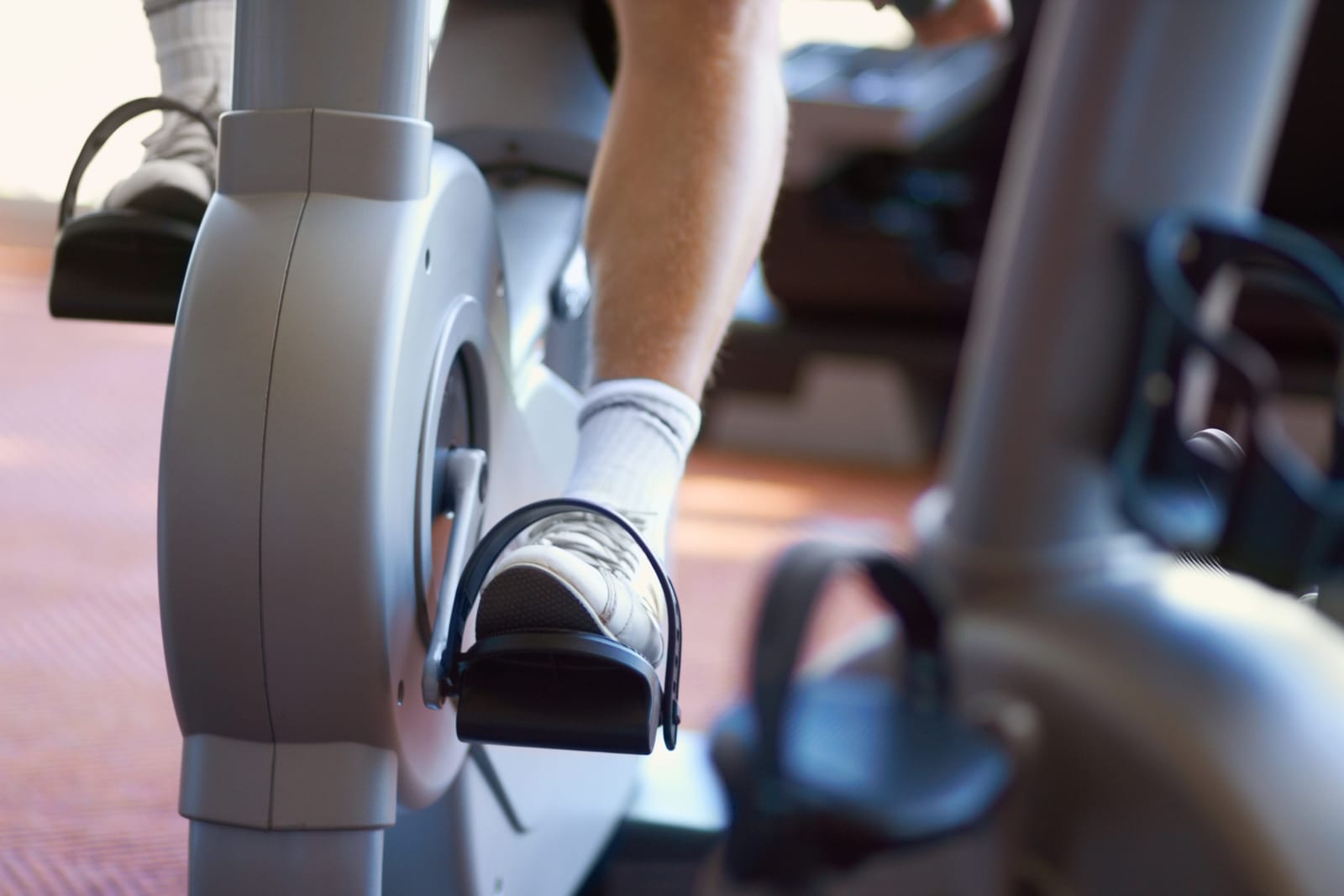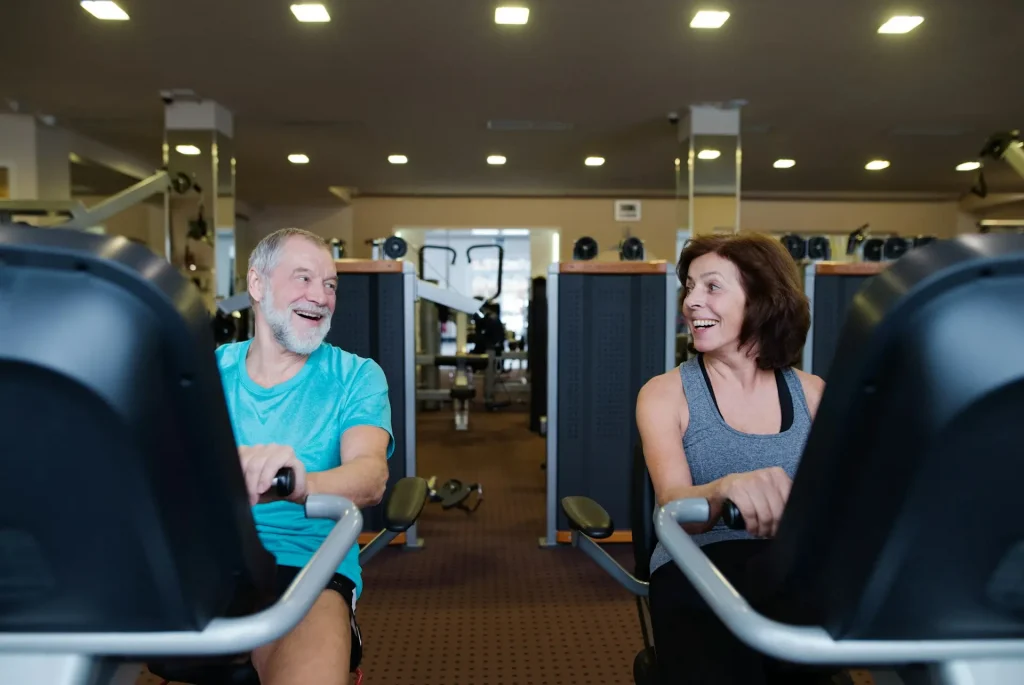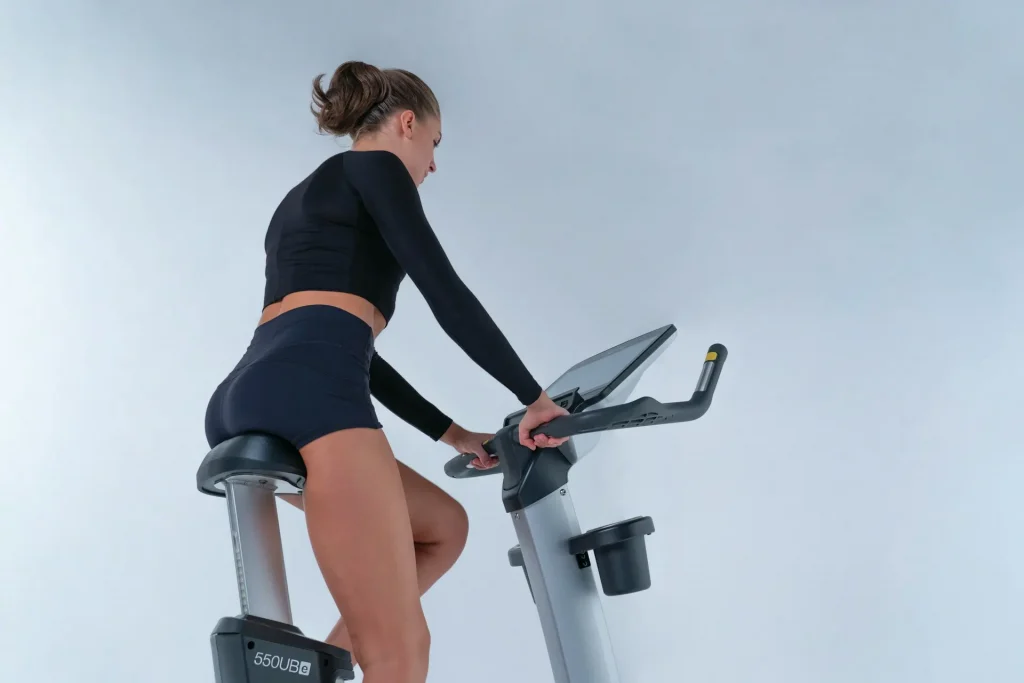
Spin Bikes vs Upright Bikes: Which is Better for Your Home Gym?
Choosing the right exercise bike for your home gym can truly make a difference in your fitness journey. At Dynamo Fitness, we understand that deciding between spin bikes and upright bikes is key to optimizing your workouts.
Each option has unique features, benefits, and drawbacks that cater to various workout preferences and goals.
In this guide, we’ll dive into the main differences between spin and upright bikes, weigh their pros and cons, and highlight the key features you should consider.
Whether you’re aiming for weight loss, endurance training, or low-impact workouts, you’ll find the insights needed to choose the perfect fit for your fitness routine and optimize every session..
Key Takeaways
- Unique Benefits for Everyone: Both spin bikes and upright bikes offer distinct benefits, depending on your fitness goals and preferences.
- High-Intensity vs. Comfort: Spin bikes are ideal for high-intensity workouts and mimic outdoor cycling classes, while upright bikes provide a more traditional, comfortable ride with versatile training options.
- Features to Focus On: Look at resistance levels, magnetic resistance, comfort, adjustability, console capabilities, price, and overall bike specifications.
Top Tip: Bookmark these key points and revisit them whenever you need a refresher on what to consider for your home gym setup.
What Are Spin Bikes and Upright Bikes?
Spin bikes and upright bikes are extremely popular among fitness enthusiasts who want to boost cardiovascular fitness and achieve their goals from the comfort of their home gym.
At Dynamo Fitness, we know that each type offers a solid cardiovascular workout but caters to different aspects of indoor training. With the rise of innovative fitness apps and engaging group cycling classes, understanding what makes each option special is essential.
- Spin Bikes: These are designed for that high-intensity cycling experience often seen in instructor-led workouts. They typically feature adjustable seats, secure pedal straps, and a variety of resistance levels—including electromagnetic options—that let you push your limits.
- Upright Bikes: These offer a more traditional cycling position with user-friendly interfaces, allowing you to easily track workout data and fitness metrics. They’re great if you’re in the mood for a relaxed ride that still delivers results.
Top Tip: Experiment with both types if possible—many of our customers find that trying a spin bike and an upright bike helps them decide which better fits their training style.
Spin Bikes vs Upright Bikes: Key Differences
The primary differences between spin bikes and upright bikes come down to design, functionality, and how you plan to use them in your workouts. We’ve gathered insights from expert reviews and user feedback to help you understand these differences clearly.
- Design and Feel: Spin bikes usually have a heavier flywheel and offer various resistance options, such as electromagnetic and motorized adjustments, for a smoother ride compared to the manual resistance of many upright bikes.
- Workout Intensity: Spin bikes tend to encourage a more aggressive riding posture, which can ramp up calorie burn and enhance performance. However, this might come at the expense of some comfort.
- Comfort and Adjustability: Upright bikes provide a more traditional and often more comfortable cycling position, which can be easier on the joints and might be preferable if you’re looking for a less intense workout.
Top Tip: Assess your personal fitness goals—if you need high intensity calorie burn, a spin bike might be your best bet. If comfort and longer sessions are more your style, consider an upright bike.
Pros + Cons of Spin Bikes
Spin bikes have earned a reputation for delivering high-intensity workouts that many fitness enthusiasts love. Here, we break down the pros and cons to help you decide if a spin bike is right for you.

Pros
- Full-Body Engagement: Spin bikes provide a comprehensive workout that ramps up calorie burn and keeps your training motivation high.
- Customizable Resistance: You can easily adjust resistance levels to match your fitness goals, making each session as challenging as you need.
- Engaging Programs: Many models come with interactive workout programs and connectivity with indoor training apps, which adds fun and variety to your workouts.
- Enhanced Features: Adjustable seats, smart pedal designs, and intuitive consoles make it simple to track your progress and push your limits.
Top Tip: To get the most out of your spin bike, try different resistance levels during your high-intensity sessions to see which setting challenges you best while still allowing proper recovery.
Cons
- Potential Discomfort: Longer rides on a spin bike can lead to discomfort, especially if proper adjustments aren’t made.
- Resistance Limitations: Some spin bikes may not offer enough resistance for those who want to push their intensity to the max.
- Form Sensitivity: Maintaining proper form can be challenging without expert guidance, which is crucial to prevent injuries.
Top Tip: Always prioritize proper form—consider working with a trainer or using instructional videos to ensure you’re pedaling correctly and safely.
Pros + Cons of Upright Bikes
Upright bikes bring a different flavor to indoor cycling. They offer a classic riding position and are often celebrated for their ease of use and comfort.

Pros
- User-Friendly: Upright bikes feature intuitive interfaces that let you easily adjust resistance and track your progress.
- Joint-Friendly: The smooth, low-impact pedaling motion minimizes stress on your joints, making them ideal for those recovering from injuries.
- Versatile Training: They support various training styles, from high-intensity interval training (HIIT) to steady-state cardio, making them suitable for all fitness levels.
- Space Efficiency: Upright bikes are often more compact, fitting neatly into smaller home gym spaces.
Top Tip: For a comfortable yet effective workout, ensure your upright bike is properly adjusted to your body. A well-aligned bike can significantly enhance both performance and comfort.
Cons
- Lower Intensity Options: Upright bikes may offer fewer resistance options compared to spin bikes, potentially limiting workout intensity.
- Less Engaging: The traditional design might not deliver the same adrenaline rush as a spin bike for those seeking a high-intensity experience.
- Limited Customization: Some models may not provide the same level of adjustable features, which could impact the overall workout efficiency for more advanced users.
Top Tip: Try out different models if possible to find the one that strikes the right balance between comfort and intensity for your specific fitness needs.
Cycle Smart: 4 Essential Tips for Choosing Your Bike
When selecting an exercise bike for your home gym, several key features will influence your decision. We want to stress the importance of understanding these factors to ensure you make a well-informed choice.
#1 Resistance Levels
Resistance levels are critical for tailoring your workouts. Whether you opt for manual or electromagnetic systems, the ability to adjust resistance directly affects the intensity and calorie burn of your sessions.
- Spin Bikes: Offer smoother transitions and typically higher intensity, making them great for HIIT.
- Upright Bikes: Often provide a more controlled, steady resistance, ideal for endurance training.
Top Tip: Try different resistance settings to see which level maximizes your workout while still being sustainable over time.
#2 Comfort + Adjustability
Comfort is key to enjoying your workout. Features such as adjustable seats and handlebars can make a huge difference in how effective and enjoyable your cycling sessions are.
- Spin Bikes: May require more adjustments to balance intensity and comfort due to a more aggressive riding position.
- Upright Bikes: Tend to offer a more traditional, comfortable cycling experience with user-friendly adjustment options.
Top Tip: Spend a few extra minutes fine-tuning your bike’s settings before your workout—it can significantly reduce discomfort and improve your overall performance.
#3 Console + Tracking Capabilities
Modern exercise bikes come with interactive consoles that allow you to monitor your workout metrics in real-time. This can help you stay motivated and track your progress over time.
- Advanced Features: Look for models that offer data on distance, calories burned, heart rate, and even integration with fitness apps.
- User Experience: A clear, intuitive interface makes it easier to set goals and adjust your workouts accordingly.
Top Tip: Use the tracking features to set small, achievable goals for each session. Monitoring your progress can be a great motivator and helps you see tangible improvements in your fitness journey.
#4 Price + Durability
Investing in quality equipment is essential. Consider both the upfront cost and the long-term durability of the bike.
- Spin Bikes: Often come with advanced features and heavier flywheels, making them slightly more expensive but ideal for high-intensity training.
- Upright Bikes: Tend to be more budget-friendly, offering solid performance at a lower price point.
Top Tip: Balance cost with long-term value by reading reviews and comparing models—this ensures you get equipment that’s both affordable and built to last.
Fat-Burning on Wheels: Which Bike Delivers?
When it comes to weight loss, spin bikes have a clear edge. Their high-intensity cycling workouts boost your heart rate and burn calories rapidly—ideal for shedding pounds.

- Spin Bikes: Their dynamic, high-intensity design makes them perfect for intense cardio sessions that can burn 400 to 600 calories in a 45-minute workout.
- Upright Bikes: While effective for steady-state cardio, they generally don’t deliver the same level of calorie burn as spin bikes.
Top Tip: If weight loss is your primary goal, integrate spin bike sessions into your routine and track your calorie burn to stay motivated and on target.
Endurance Edge: Which Bike Powers Your Cardio?
Both spin bikes and upright bikes can boost cardiovascular fitness and endurance, but each offers a slightly different experience.
- Spin Bikes: Ideal for interval training, they allow you to switch between high-intensity bursts and recovery periods. This variability improves both cardiovascular health and muscular endurance.
- Upright Bikes: Provide a consistent, steady-state workout that is excellent for building long-term endurance without excessive joint stress.
Top Tip: For optimal cardio results, mix high-intensity intervals with steady-state sessions. This approach maximizes both endurance and calorie burn.
Easy on the Joints: Your Ideal Low-Impact Bike
If low-impact workouts are a priority—especially if you’re recovering from an injury or have joint issues—upright bikes are generally the way to go.
- Upright Bikes: Designed with ergonomics and comfort in mind, they minimize stress on your knees and hips, making them excellent for gentle, joint-friendly workouts.
- Spin Bikes: Can be adjusted for low-impact use, but typically, the aggressive riding position may be less comfortable for prolonged sessions if you have mobility concerns.
Top Tip: If joint comfort is critical, adjust your bike’s seat and handlebars to support your natural posture, and start with lower resistance levels until you build strength gradually.
Crank Up the Intensity: Which Bike Wins HIIT Workouts?
For high-intensity workouts, spin bikes really shine with their advanced resistance systems and aggressive riding positions.
- Spin Bikes: They allow you to switch effortlessly between intense sprints and recovery phases, making them ideal for HIIT sessions that challenge your cardiovascular and muscular endurance.
- Upright Bikes: While great for steady training, they generally don’t offer the same intensity that can push your performance to the next level.
Top Tip: Incorporate regular HIIT sessions on your spin bike, and use a heart rate monitor to ensure you’re hitting your peak zones for maximum benefits.
Home Gym Space Hack: Find Your Ideal Compact Bike
Space considerations are crucial when setting up a home gym. The physical footprint of your equipment can make all the difference.
- Spin Bikes: Typically have a larger base, which is excellent for stability during high-intensity workouts, but may require more room.
- Upright Bikes: Often more compact and sometimes offer foldable options, making them perfect for smaller spaces without sacrificing performance.
Top Tip: Measure your available space carefully before purchasing, and consider foldable options or smart storage solutions to maximize your home gym layout.
Ride to Success: Pick a Bike That Drives Your Success
We’re dedicated to helping you choose the perfect exercise bike for your home gym. Whether you’re drawn to the high-intensity challenge of spin bikes or the comfort and versatility of upright bikes, the right equipment will boost your workouts and help you reach your fitness goals.
Remember, your decision should be based on your personal fitness objectives, comfort needs, and available space. Explore our extensive collections—including our spin bikes and our home gyms range—to find the perfect addition to your workout arsenal.
Consistency is key—regularly update your workout routine, monitor your progress, and don’t be afraid to adjust your equipment settings to continuously challenge yourself and achieve long-term success.
For more expert advice contact us online if you have any questions, or find your nearest showroom to test out a few bikes before you buy.
Power up your home gym and pedal your way to a healthier, fitter future.
[sp_easyaccordion id=”5705″]